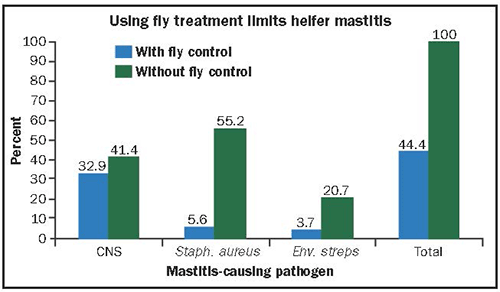Mastitis control during hot summer months is important to the health of mammary glands and milk quality. In northern Europe, "summer mastitis" occurring during July, August and September is associated with infected flies biting cows' teats. This type of mastitis, caused by Arcanobacterium pyogenes, is typically controlled using insecticidal sprays.
Don't overlook fly control
In the U.S., fly season begins as early as April and lasts through September or early October, especially in the Southeast. Following the National Mastitis Council's "10-point plan" for mastitis control has led to a reduction in the level of intramammary infections.
However, the importance of fly control in reducing cases of mastitis has been overlooked. Many producers do implement fly control techniques in an attempt to reduce insect populations on the farm premises (barns, hutches and so forth) and on cattle. However, insecticidal control techniques are often not applied to specifically control mastitis among the herd's cows and heifers.
With temperatures and humidity steadily rising in recent months, numbers of blood-sucking horn flies (Haematobia irritans) will skyrocket. This species is commonly found on the backs of dairy animals but will also attack the teats, leading to the development of mastitis, especially among heifers.
Research has identified a greater prevalence of mastitis caused by Staphylococcus aureus in dairy heifers that had teat ends covered in scabs caused by the horn fly. Additionally, studies have shown a lower prevalence of mastitis caused by Staph. aureus among heifers in herds using fly control compared to herds not using a fly control program (see figure). The greatest reductions in mastitis prevalence among heifers from herds using fly control were seen in cases caused by Staph. aureus.
So, how is Staph. aureus spread from fly to animal and from animal to animal? Horn flies carrying Staph. aureus zero in on the teat ends of dairy heifers and suck blood from vessels below the teat skin. This causes the formation of abscesses and scabs with their invasive mouth parts, subsequently depositing Staph. aureus. This places these bacteria in an opportune position to enter the teat canal and cause an intramammary infection.
Flies serve as the vectors and carry bacteria from animal to animal, resulting in an elevated prevalence of Staph. aureus mastitis.

Front teats hit hardest
In an ongoing trial at the University of Georgia-Athens (UGA), teat ends of heifers were monitored before, during and after fly season. At the beginning of fly season and before application of a control program, teats were populated with blood-sucking flies and bloody scabs associated with Staph. aureus intramammary infections.
Less than 48 hours after pour-on insecticide administration, fly populations were drastically smaller, and less than two weeks later teats were healed and free of scabs. However, the damage had been done and Staph. aureus infections were established, which were subsequently cured with antibiotic therapy. Overall, the prevalence of Staph. aureus intramammary infections among quarters of dairy heifers was 30 percent (60 percent of heifers).
Interestingly, prevalence of mastitis caused by Staph. aureus was greater in front quarters compared to rear quarters. Horn flies are attracted to the navel area of the heifers which is in close proximity to the front teats. Also, the tail switch may be more effective at repelling flies from biting the rear teats. Not only do these flies provide a vector for the spread of Staph. aureus but are also a nuisance to the already stressed animals during hot weather.
Maintain the environment
What can you do to protect your heifers? Sanitation is key in reducing the farm populations of different types of flies. Proper management of manure, water troughs, and leftover feed reduces fly numbers and may reduce the mastitis cases caused by flies. However, maintaining a sanitary environment alone may not be effective at reducing all insect populations of concern to a desirable level.
Several different fly control techniques exist such as aerosols, bait, strips, foggers, dust bags, traps, oilers, insecticidal ear tags, insecticidal pour-on solutions and feed supplementation with insect growth regulators.
The use of an insecticidal pour-on every two weeks for six weeks followed by placement of insecticidal ear tags was found to reduce fly populations and lower the incidence of new Staph. aureus infections in heifers by 83 percent in a six-month efficacy trial at Louisiana State University.
At UGA, the use of a pour-on every two to four weeks was found to drastically reduce fly populations, allowing teats to heal, and reducing two important sources of Staph. aureus: flies and scabs.
While there are no techniques that are 100 percent effective, the use of some type of fly control is important in reducing mastitis cases in dairy heifers and, in turn, reducing SCC when they freshen. With the probable reduction in the SCC legal limit to 400,000/mL in the near future, all feasible methods that will lead to improvements in your farm's milk quality are essential to consider.
Don't let flies cost you money due to additional mastitis, elevated SCC and loss of quality product premiums when your heifers enter the milking herd.
This article appears on page 333 of the May 10, 2013 issue of Hoard's Dairyman






